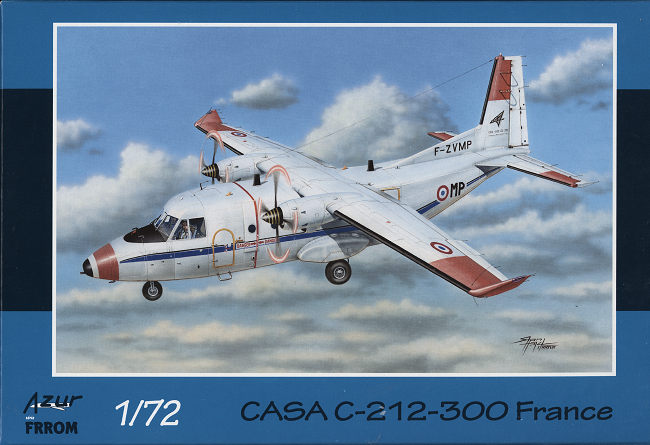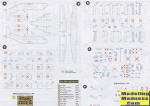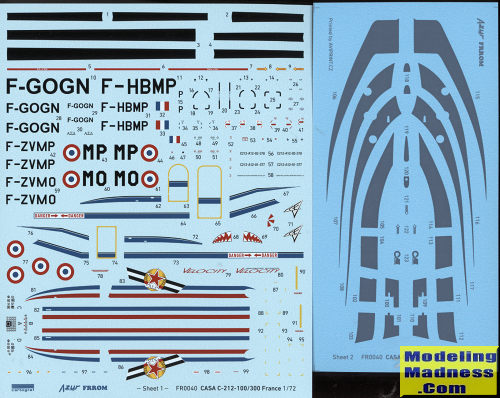
Azur/FRROM 1/72 CASA C.212-300
| KIT #: | FR0040 |
| PRICE: | $ |
| DECALS: | Four options |
| REVIEWER: | Scott Van Aken |
| NOTES: |

| HISTORY |
During the late 1960s, the Spanish Air Force was still operating a number of outdated piston-engine transports, including the three-engine Junkers Ju 52 and two-engine Douglas C-47. In order to meet the Spanish Air Force's needs to modernize its transport force, CASA proposed the C-212, a twin engine 18 seat transport aircraft that would be capable of fulfilling a variety of military roles, including passenger transport, ambulance aircraft and paratroop carrier, while also being suitable for civil use. The first prototype flew on 26 March 1971. In 1974, the Spanish Air Force decided to acquire the Aviocar to update its fleet.
Airlines took note of the type's success with the military, so CASA developed a commercial version, the first examples of which were delivered in July 1975. In August 2006 a total of 30 CASA C-212 aircraft (all variants) remain in airline service around the world. The -400 was introduced in 1997 with a glass cockpit and more powerful engines.
In 2010, Airbus Military said it could no longer afford to produce the C212 in Europe and after production in Seville slowed to four in two years, the last C-212 produced in Spain was delivered in late December 2012 to the Vietnam Marine Police. Over 42 years, 477 aircraft have been produced for 92 operators.
| THE KIT |
 This
kit is of the -300 variation of the CASA 212. Some of the recognition features
of the aircraft are the winglets and in most models, a longer nose. Azur/FRROM
kits are, of course, developed mostly by MPM so the plastic in this one is
mostly the same as that of the Special Hobby kits. However, true to the brand
name, this kit is mostly of aircraft operated by the French.
This
kit is of the -300 variation of the CASA 212. Some of the recognition features
of the aircraft are the winglets and in most models, a longer nose. Azur/FRROM
kits are, of course, developed mostly by MPM so the plastic in this one is
mostly the same as that of the Special Hobby kits. However, true to the brand
name, this kit is mostly of aircraft operated by the French.
Since much of the plastic is identical to the SH kit, I'll repeat what was said before. However, I should point out that for three of the four options, you will need to perform some major surgery. The base kit is the short nose version and as you can see in the box art, this is the long nose plane. It means you have to cut away the base nose and install the new one. This has been well thought out and the cut is made at the panel like behind the large forward inserts. This means minimal cutting. The new part has ledges that fit onto the rest of the fuselage for a good fit.
There are a lot of parts that are not used. In fact, I'd be surprised if, in terms of numbers, you use even half of the pieces available on the sprues. Obviously the C.212 was built in many variants and had a lot of options depending on the requirements of the customer. This has a real benefit for SH in that they can produce a rather large number of different boxings using the same basic sprues. Another benefit is that those who are knowledgeable on the aircraft can build something different from what is called for in the instructions.
Let me start off by discussing those bits that are different. There are large inserts for the forward door area on both sides of the fuselage and different rear doors. There are also different landing gear sponsons. Also different are horizontal stabs, elevators, rudders, props, instrument panels, noses, and windows. In fact, it looks as if one of the later boxings will have square rather than round windows on the side, which will mean either cutting the current round ones or different fuselage halves.
The cockpit is well appointed up to the bulkhead behind the seats. You have decals you can put on the instrument panel if you so wish. There is no cabin detail and you cannot pose the rear ramp down unless you do some cutting then there would be nothing to see inside. All of the clear bits save for the windscreen need to be installed from the inside so prepainting around those areas may be a good idea. I daresay considerable nose weight will be needed so you need to plan for that. No amount is specified in the instructions.
Wings are a single upper section with two lower
halves. All the flap hinges are separate. Engine nacelles are three parts and
you are to install the prop prior to gluing the engine face to the nacelle.
Typical of modern planes, there are a numbe r of antennas to add and you need to
open holes for some, measure hole locations before drilling for others and on
some parts of the airframe, there are panel lines that need to be filled. Note
that this plane does not have retractable landing gear so no gear doors to worry
about.
r of antennas to add and you need to
open holes for some, measure hole locations before drilling for others and on
some parts of the airframe, there are panel lines that need to be filled. Note
that this plane does not have retractable landing gear so no gear doors to worry
about.
Instructions are very well done and with color to help you during construction. They also provide all the information on where to put antennas, what to cut away, and what lines to fill. Photo etch is minimal and mostly for antennas. You will have to know which variant you want to build rather early on in the build so keep that in mind. Two planes are those operated by the French flight test center so have quasi-military markings. They are in white with da-glo tips and a blue cheat line. Another is the short nose version operated by Boogie Performance. It is all white with the red and blue cheat line. The fourth is in overall light grey with the dark grey livery and was operated by CAE Aviation. There are two decal sheets with the main one printed by Cartograf and the smaller one printed by Propagteam. The decals include the de-icer boots so that is a nice touch.
| CONCLUSIONS |
This is a very nice boxing that offers some interesting livery options of a later version of this important type.
| REFERENCES |
https://en.wikipedia.org/wiki/CASA_C-212_Aviocar
July 2018
Copyright ModelingMadness.com. All rights reserved.
Thanks to Azur/FRROM for the preview kit. Get yours from your favorite
retailer or have them order it in for you. If you would like your product reviewed fairly and fairly quickly, please
contact
the editor or see other details in the
Note to
Contributors. Back to the Main Page
Back to the Review
Index Page
Back to the Previews Index Page